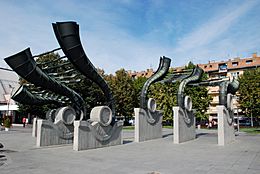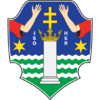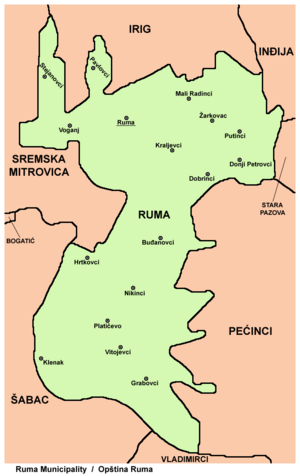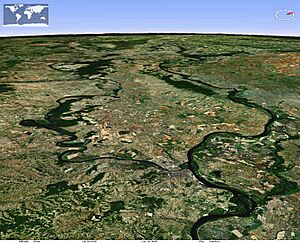Ruma facts for kids
Quick facts for kids
Ruma
Рума (Serbian)
|
||
|---|---|---|
|
Town and municipality
|
||
|
From top: Monument of the Revolution, Downtown, Monument to a horse, Serbian Orthodox Church of the Holy Ascension of the Lord, One of the two statues of the monument to the plague, Croatian Home, New Orthodox Church
|
||
|
||
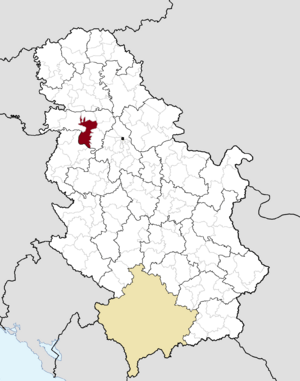
Location of the municipality of Ruma within Serbia
|
||
| Country | ||
| Province | ||
| Region | Syrmia | |
| District | Srem | |
| Municipality | Ruma | |
| Settlements | 17 | |
| Area | ||
| • Town | 68.66 km2 (26.51 sq mi) | |
| • Municipality | 582.02 km2 (224.72 sq mi) | |
| Elevation | 112 m (367 ft) | |
| Population
(2022 census)
|
||
| • Town | 27,747 | |
| • Town density | 404.12/km2 (1,046.67/sq mi) | |
| • Municipality | 48,621 | |
| • Municipality density | 83.5384/km2 (216.363/sq mi) | |
| Time zone | UTC+1 (CET) | |
| • Summer (DST) | UTC+2 (CEST) | |
| Postal code |
22400
|
|
| Area code | +381(0)22 | |
| Car plates | RU | |
Ruma is a town and a municipality located in the Srem District of Vojvodina, which is an area in Serbia. In 2011, about 30,076 people lived in the town itself. The whole municipality, which includes Ruma and nearby villages, had a population of 54,339 people.
Contents
History of Ruma: A Journey Through Time
Early Life in Ruma: Ancient Times
People have lived in the Ruma area for a very long time. We know this from old discoveries that go back to prehistory. One important place is Gomolava, near Hrtkovci. Here, archaeologists found special tombs from the Bronze Age. They also found pottery from the Vučedol culture that is about 5,000 years old.
The first groups of people known to live here were the Illyrians and Celts. These included groups like the Amantini and Scordisci. Later, during the time of the Roman Empire, the local people started to adopt Roman ways of life. There weren't big Roman cities in Ruma. Instead, there were farms called "villae rusticae."
Changes and New Rulers: Middle Ages
Over time, different groups moved into the area. These included the Huns, Germanic peoples, and Slavs. These migrations changed the Roman culture here. In the centuries that followed, the region was ruled by different empires. These included the Frankish Empire, the First Bulgarian Empire, the Byzantine Empire, and the Kingdom of Hungary.
How Ruma Began: First Mentions
The name "Ruma" was first written down in 1566 or 1567. This was in a record from the Ottoman Empire. At that time, Ruma was a small village. It had 49 houses, a church, and three priests. Most of the people living there were Serbs.
Ruma Grows: Habsburg Rule and Rebellions
From 1718, Ruma was part of the Habsburg monarchy. In 1746, the town of Ruma was officially founded. It was built close to the original village. The first people to move to the new town were Serbs from nearby places. Germans also came from Germany to live there. Later, in the early 1800s, Croats and Hungarians also settled in Ruma.
In 1807, a big uprising by farmers happened in the Syrmia region. It was called the Tican's Rebellion and started near Ruma, in the village of Voganj. During the Revolutions of 1848, Ruma became a key place for the Serbian national movement in Syrmia.
Ruma in the 20th Century: Wars and Changes
In the early 1900s, Ruma was an important district capital. In 1910, the Ruma municipality had about 49,138 people. Many spoke Serbian, German, Hungarian, and Croatian.
After the Habsburg Monarchy ended, the Syrmia region decided to join the Kingdom of Serbia. This happened in Ruma on November 24, 1918. In 1933, Ruma officially became a city.
When World War II started, Ruma had a large German population. Many non-German citizens of Ruma fought against the occupation. In 1944, most Germans left the town to escape the war. After the war, new families moved to Ruma from other parts of what was then Yugoslavia. In the 1990s, about 10,000 people seeking safety from conflicts in Croatia, Bosnia, and Kosovo also settled in Ruma.
In 1949, a pilot school and other aviation schools opened in Ruma. These were supported by the Air Forces of Yugoslavia. This led to an amazing International air show in the town in 1950.
Villages in Ruma Municipality
The Ruma municipality includes the town of Ruma and these villages:
- Buđanovci
- Vitojevci
- Voganj
- Grabovci
- Dobrinci
- Donji Petrovci
- Žarkovac
- Klenak
- Kraljevci
- Mali Radinci
- Nikinci
- Pavlovci
- Platičevo
- Putinci
- Stejanovci
- Hrtkovci
People of Ruma: Population and Groups
According to the 2011 census, the Ruma municipality has 54,339 people.
Different Ethnic Groups in Ruma
The municipality of Ruma is home to many different ethnic groups. Serbs make up the largest group in all settlements. Here's a look at the different groups:
| Ethnic group | Population | % |
|---|---|---|
| Serbs | 46,891 | 86.29% |
| Croats | 1,719 | 3.16% |
| Romani | 1,297 | 2.39% |
| Hungarians | 1,171 | 2.15% |
| Yugoslavs | 267 | 0.49% |
| Macedonians | 153 | 0.28% |
| Albanians | 57 | 0.10% |
| Montenegrins | 54 | 0.10% |
| Slovaks | 50 | 0.09% |
| Germans | 49 | 0.09% |
| Muslims | 39 | 0.07% |
| Others | 2,592 | 4.77% |
| Total | 54,339 |
Economy: How People Work in Ruma
The table below shows how many people were working in different types of jobs in Ruma in 2018. This gives us an idea of the main industries in the area.
| Activity | Total |
|---|---|
| Agriculture, forestry and fishing | 427 |
| Mining and quarrying | 8 |
| Manufacturing | 6,762 |
| Electricity, gas, steam and air conditioning supply | 217 |
| Water supply; sewerage, waste management and remediation activities | 215 |
| Construction | 579 |
| Wholesale and retail trade, repair of motor vehicles and motorcycles | 1,999 |
| Transportation and storage | 809 |
| Accommodation and food services | 338 |
| Information and communication | 111 |
| Financial and insurance activities | 136 |
| Real estate activities | 4 |
| Professional, scientific and technical activities | 333 |
| Administrative and support service activities | 149 |
| Public administration and defense; compulsory social security | 550 |
| Education | 713 |
| Human health and social work activities | 748 |
| Arts, entertainment and recreation | 161 |
| Other service activities | 200 |
| Individual agricultural workers | 635 |
| Total | 15,094 |
Famous People from Ruma
Many notable individuals have come from Ruma, including:
- Aleksandar Berček, an actor
- Miloš Bosančić, a Serbian football player
- Brana Crnčević, a writer
- Stjepko Gut, a jazz musician
- Paško Rakić, a neuroscientist
- Atanasije Stojković, a scientist and writer
- Danilo Pantić, a Serbian football player
Sister Cities
Ruma has special connections with other cities around the world, known as "sister cities":
Image gallery
See also
 In Spanish: Ruma para niños
In Spanish: Ruma para niños


